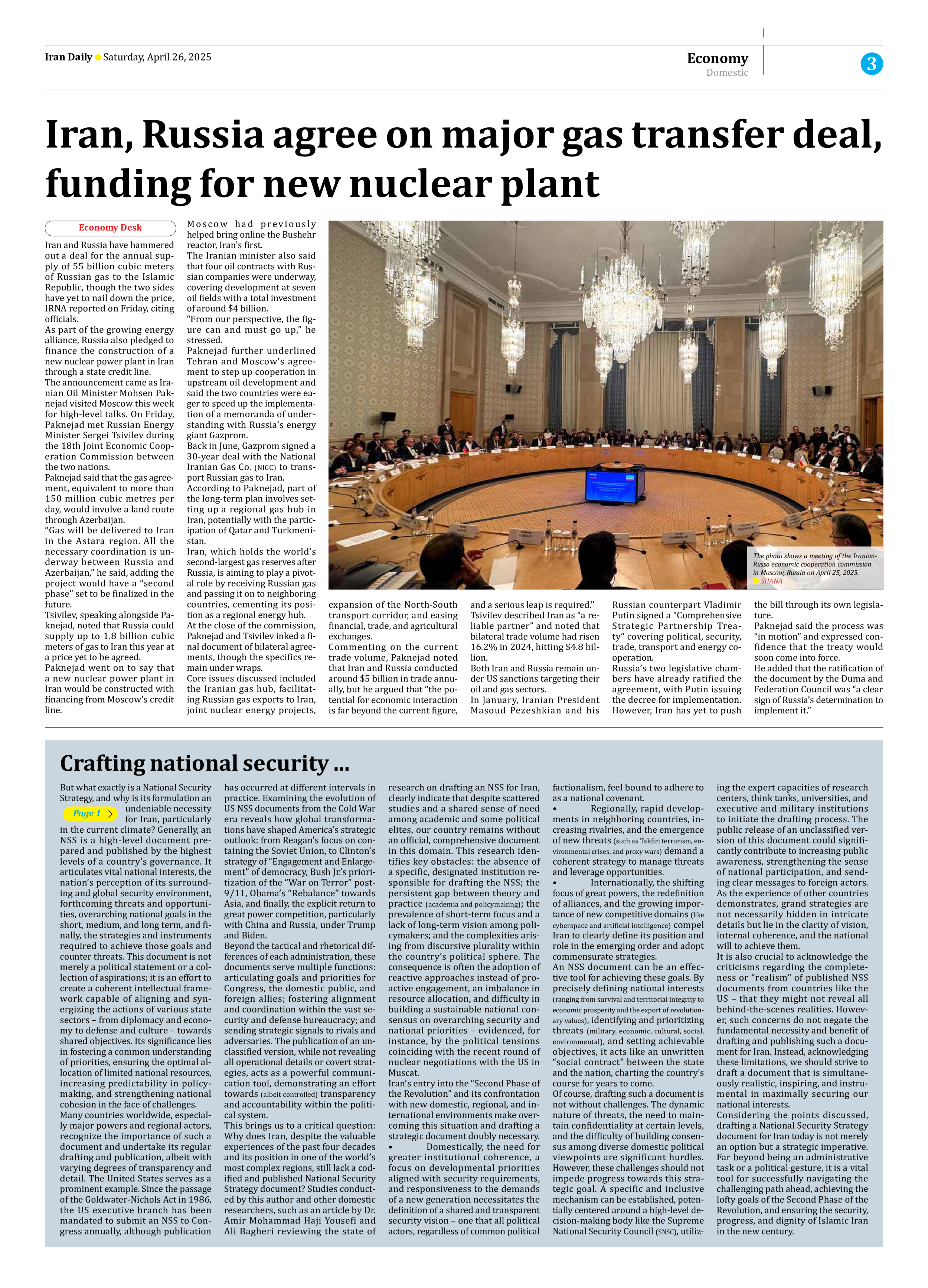
Crafting national security ...
Page 1
But what exactly is a National Security Strategy, and why is its formulation an undeniable necessity for Iran, particularly in the current climate? Generally, an NSS is a high-level document prepared and published by the highest levels of a country’s governance. It articulates vital national interests, the nation’s perception of its surrounding and global security environment, forthcoming threats and opportunities, overarching national goals in the short, medium, and long term, and finally, the strategies and instruments required to achieve those goals and counter threats. This document is not merely a political statement or a collection of aspirations; it is an effort to create a coherent intellectual framework capable of aligning and synergizing the actions of various state sectors – from diplomacy and economy to defense and culture – towards shared objectives. Its significance lies in fostering a common understanding of priorities, ensuring the optimal allocation of limited national resources, increasing predictability in policymaking, and strengthening national cohesion in the face of challenges.
Many countries worldwide, especially major powers and regional actors, recognize the importance of such a document and undertake its regular drafting and publication, albeit with varying degrees of transparency and detail. The United States serves as a prominent example. Since the passage of the Goldwater-Nichols Act in 1986, the US executive branch has been mandated to submit an NSS to Congress annually, although publication has occurred at different intervals in practice. Examining the evolution of US NSS documents from the Cold War era reveals how global transformations have shaped America’s strategic outlook: from Reagan’s focus on containing the Soviet Union, to Clinton’s strategy of “Engagement and Enlargement” of democracy, Bush Jr.’s prioritization of the “War on Terror” post-9/11, Obama’s “Rebalance” towards Asia, and finally, the explicit return to great power competition, particularly with China and Russia, under Trump and Biden.
Beyond the tactical and rhetorical differences of each administration, these documents serve multiple functions: articulating goals and priorities for Congress, the domestic public, and foreign allies; fostering alignment and coordination within the vast security and defense bureaucracy; and sending strategic signals to rivals and adversaries. The publication of an unclassified version, while not revealing all operational details or covert strategies, acts as a powerful communication tool, demonstrating an effort towards (albeit controlled) transparency and accountability within the political system.
This brings us to a critical question: Why does Iran, despite the valuable experiences of the past four decades and its position in one of the world’s most complex regions, still lack a codified and published National Security Strategy document? Studies conducted by this author and other domestic researchers, such as an article by Dr. Amir Mohammad Haji Yousefi and Ali Bagheri reviewing the state of research on drafting an NSS for Iran, clearly indicate that despite scattered studies and a shared sense of need among academic and some political elites, our country remains without an official, comprehensive document in this domain. This research identifies key obstacles: the absence of a specific, designated institution responsible for drafting the NSS; the persistent gap between theory and practice (academia and policymaking); the prevalence of short-term focus and a lack of long-term vision among policymakers; and the complexities arising from discursive plurality within the country’s political sphere. The consequence is often the adoption of reactive approaches instead of proactive engagement, an imbalance in resource allocation, and difficulty in building a sustainable national consensus on overarching security and national priorities – evidenced, for instance, by the political tensions coinciding with the recent round of nuclear negotiations with the US in Muscat.
Iran’s entry into the “Second Phase of the Revolution” and its confrontation with new domestic, regional, and international environments make overcoming this situation and drafting a strategic document doubly necessary.
• Domestically, the need for greater institutional coherence, a focus on developmental priorities aligned with security requirements, and responsiveness to the demands of a new generation necessitates the definition of a shared and transparent security vision – one that all political actors, regardless of common political factionalism, feel bound to adhere to as a national covenant.
• Regionally, rapid developments in neighboring countries, increasing rivalries, and the emergence of new threats (such as Takfiri terrorism, environmental crises, and proxy wars) demand a coherent strategy to manage threats and leverage opportunities.
• Internationally, the shifting focus of great powers, the redefinition of alliances, and the growing importance of new competitive domains (like cyberspace and artificial intelligence) compel Iran to clearly define its position and role in the emerging order and adopt commensurate strategies.
An NSS document can be an effective tool for achieving these goals. By precisely defining national interests (ranging from survival and territorial integrity to economic prosperity and the export of revolutionary values), identifying and prioritizing threats (military, economic, cultural, social, environmental), and setting achievable objectives, it acts like an unwritten “social contract” between the state and the nation, charting the country’s course for years to come.
Of course, drafting such a document is not without challenges. The dynamic nature of threats, the need to maintain confidentiality at certain levels, and the difficulty of building consensus among diverse domestic political viewpoints are significant hurdles. However, these challenges should not impede progress towards this strategic goal. A specific and inclusive mechanism can be established, potentially centered around a high-level decision-making body like the Supreme National Security Council (SNSC), utilizing the expert capacities of research centers, think tanks, universities, and executive and military institutions to initiate the drafting process. The public release of an unclassified version of this document could significantly contribute to increasing public awareness, strengthening the sense of national participation, and sending clear messages to foreign actors. As the experience of other countries demonstrates, grand strategies are not necessarily hidden in intricate details but lie in the clarity of vision, internal coherence, and the national will to achieve them.
It is also crucial to acknowledge the criticisms regarding the completeness or “realism” of published NSS documents from countries like the US – that they might not reveal all behind-the-scenes realities. However, such concerns do not negate the fundamental necessity and benefit of drafting and publishing such a document for Iran. Instead, acknowledging these limitations, we should strive to draft a document that is simultaneously realistic, inspiring, and instrumental in maximally securing our national interests.
Considering the points discussed, drafting a National Security Strategy document for Iran today is not merely an option but a strategic imperative. Far beyond being an administrative task or a political gesture, it is a vital tool for successfully navigating the challenging path ahead, achieving the lofty goals of the Second Phase of the Revolution, and ensuring the security, progress, and dignity of Islamic Iran in the new century.







